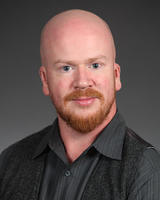
Professor Brandon Sanderson, M.F.A.
Director of Pembroke Undergraduate Research and Creativity Center and Professor of Art-Printmaking
About
Biography
Entering his 24th year as a professor and 30th as an exhibiting artist, Brandon Sanderson currently serves as the sixth Director of the Pembroke Undergraduate Research and Creativity (PURC) Center and as Professor of Art teaching Printmaking and Drawing. He teaches multiple levels of drawing and all levels of printmaking, including new technologies, intaglio, screenprinting, lithography, and relief. In 2021 he received UNCP's Outstanding Teaching and Outstanding Research Mentor awards. Since 2013, he has served as Workshop Coordinator for Frogman's Print Workshops at the University of Iowa, the largest printmaking workshops in the United States. Sanderson holds the Bachelors of Science degrees from Colorado State University-Pueblo in Printmaking/Drawing, the Bachelors of Science degrees from Colorado State University-Pueblo in Computer Information Systems and the Masters of Fine Art degree in Art with a specialty of Printmaking from the University of South Dakota where he studied under 20th century print and paper artist Lloyd Menard. Prior to his career as an artist, Sanderson worked as a computer programmer and systems analyst.
Since 1995, Sanderson has exhibited in over 575 venues in 65 countries. Recently he has shown in Poland, Palestine, Chile, Bosnia, Uganda, Cambodia, Colombia and Ukraine. He has also held 37 university lectures in 27 states and participated in 81 collaborative studio projects. In 2018 he was the first visiting artist in the West Virginia University Master Printmaking series. He also is a long-time member of the Artnauts international art group, which uses the visual arts as a tool for addressing global change. Sanderson’s work appeared in the nationally acclaimed “Re-Riding History” exhibit, which featured works by 72 contemporary native and non-native artists who responded to the events surrounding the 1875-1878 capture, relocation and imprisonment of 72 Plains Indian warriors at Fort Marion, St. Augustine, Florida.
In his time at UNCP, he has organized dozens of exhibitions and brought in 57 visiting artists to work with faculty, students and the community. He was recently awarded a number of grants to use his technical and artistic backgrounds to design and prototype art equipment that is cost-effective and accessible to those with disabilities. His current body of work combines laser cutters, CNC machines, 3D printers, and digital drawings with the traditional tools of the printmaking and drawing studios.
Artist Statement
“Character cannot be developed in ease and quiet. Only through experience of trial and suffering can the soul be strengthened, ambition inspired, and success achieved.” – Helen Keller
For as long as I can remember, my art work has been based on the interaction of mechanical and organic parts within myself and in the world around me. Having artificial parts such as pins in a knee and re-constructed inner ears, I found, and still find, the tool, the android, the automaton to be an appropriate symbol of our capacity for alienation, devastation and simultaneously growth and creation.
Recently that work has grown to focus on my life-long hearing disability and the effect it has on my life experiences. My hearing ranges from complete deafness to hearing at about half the level of the average working individual. I read lips to communicate with others – one can imagine how that well that worked with COVID. It is a situation of attempting to find comfort in discomfort, of accepting what I cannot change, changing what I can and simply pushing through. As Helen Keller put it: “the experience of trial and suffering”. I can only benefit from this if I not only accept it, but endeavor to love it. It is human nature to reject the unfamiliar, the uncomfortable, the painful; yet I’ve learned from my greatest mentors and teachers that meaningful growth comes from embracing and reflecting on suffering.
And that's what my characters do. They aren't elegant or graceful – rather the opposite, as if they were hastily reassembled in someone's garage. They're in survival mode, a constant state of growth and adaptation. Each of them represents a specific situation or amalgamation thereof. They are not comfortably sequestered with ‘their own’ – they have no safety net, no comfort zone, they must address each moment as it comes and evolve within it. They must see reality as it is, not as they want it to be.
Alienation and isolation is another aspect of my work. Significant hearing loss prevents the individual from participating in the larger community without assistance. This is often seen as aloofness. The isolation necessitated by this condition will make a person feel anxious and alone, as if they have no real role or sense of belonging. One is often treated, regardless of current abilities or record of achievement, as if they have no ability to contribute to society. This is represented in my work by blank white space or various kinds of chaotic mark making meant to represent persistent tinnitus and bouts of complete deafness. It is also represented by the various mechanical ‘MacGyverisms’ of the characters, the improvised means of pushing forward. In summary, my recent work is an exploration of my life-long disability, the psychological impact of it, and the adaptations that I and others have made to continue functioning as a result.
Websites